Foreign Insulators
by Marilyn Albers
Reprinted from "INSULATORS - Crown Jewels of the Wire", September 1984, page 3
DON FIENE TAKES A TRIP TO THE
USSR
My column in the July '84 issue of Crown Jewels included a letter from Don
Fiene (Knoxville, TN), which said he would be going to Russia in June. When he
returned, he wrote me this delightful account of his travels, and, of course,
the inevitable insulator finds!
He made good pencil sketches of the insulators
for me, which is exactly what we need to make accurate drawings of them. But I
did not think these would print too well, so I tried to trace over them with
ink. Unfortunately, they don't look as good as his sketches did, but at least
you can get the general idea! He encouraged me to share his letter with you.
Dear Marilyn,
I returned from the USSR on June 23 (left NYC June 9). I led a
group of 40 people and had little time for really serious insulator searching.
Still, I picked up a few items. I never found the mother lode, though, and
that's all the more disappointing, as I was able to get the stuff I had through
customs with no hassle. I'll comment on what I found in the order they are
described on the enclosed sheets.
The only glass piece I obtained came from a
small village on the shore of Lake Baikal in far eastern Siberia. This lake is
the deepest, coldest, clearest, largest, oldest lake on the planet; it contains
20 percent of the earth's fresh water. It is located 3100 miles east of Moscow
and a few hundred miles north of Ulan Bator, the capital of Outer Mongolia. We traveled
there four days on the Trans-Siberian Express, which, so far as I could tell, was
electrified the entire distance. This means that I saw no fewer than 8 billion
insulators en route -- many of them quite exotic looking glass power types in
interesting shades of light blue and green. Most were porcelain, of course. We
made about 15 stops, most only 5 minutes, but five dragged on for 15 minutes. I
hiked into the train yards as far as I dared go, but never saw the first
insulator within stealing distance. I might mention, though, for the edification
of train buffs, that we passed through two smallish towns where part of the
train yards were given over to storage areas for steam locomotives. The only one
of these I saw seemed to have at least 100 engines. We saw no working steam
engines the entire trip. Probably these have all been replaced -- the last but
recently -- by electric and diesel. (But you never know; perhaps a few are still
hanging on in the far north.)
Our train let us off at Irkutsk, a major city at
the foot of Lake Baikal. I thought the place would have about fifty log cabins
and a grocery store, but it turned out to be a large and beautiful metropolis
with a population of 550,000. This is at the latitude of Labrador. The people
are quite handsome and very tall -- most unusual because Russians are short and
Orientals are short, yet, while Russians dominate, pure Mongols are common and
people of Eurasian mixture are to be seen everywhere. Whatever the secret of the
health and beauty of the Siberian people, they have had 300 years to develop
their own style. That's how long ago Irkutsk was founded! Now and then I could
see some similarities to Montana -- but Montana is just too new a place. It has no
cultural depth and no true sense of racial integration. And it's too far south.
We arrived at Irkutsk around noon, about 8 hours late. (Track repairs held us
up.) We were all very tired. Four days of light sleep, no bathing, and too much
booze had taken their toll. As one last digression, I think I'll mention that I
shared my four bed compartment with a Swede, a Russian worker who helped lay the
recent gas pipeline to Europe, and a remarkably beautiful young Russian woman
named Julia. (I forget the names of the other jerks.)
As soon as our late lunch
was over, around 3 p.m., I grabbed a "river tram" (hydrofoil boat) and
crossed the Angara River to a stop close to a railroad. I then walked the tracks
of the main Siberian line for two hours and failed to find one lousy insulator;
nor were there any interesting items on the nearby poles. All I had to show for
my walk were two types of date nail and four dates: three in the 1950's and
1971. Also, I noticed track maintenance was good; all the spikes were in all
their holes, and none were loose.
The next day we toured the lake by boat and
returned by bus. The bus stopped at a village. We were given an hour to stroll
through the place and check it out. All the houses were built of logs, but they
were large and comfortable-looking. Most had TV antennas. There was no running
water. Pumps were situated on the unpaved streets about every 300 yards. There
was electricity. Standard voltage in the USSR is 220. Lines coming into the
houses were tied to very small insulators. One such insulator I spotted in the
local store. I thought is was a fence insulator, as it measured only I"
high by 3/4" wide. But later I saw one on a house. I bought one as a
souvenir. It cost me 3 kopeks (about 4 cents). Most of the poles carried only
porcelain insulators (white); but there was some glass -- and some of it looked
heart-breakingly old, of a bubbly, translucent cobalt color. But the poles were
high and I was afraid to climb anyway. I wandered through several mini-dumps at
the edge of the village and found zero. Finally all the teenagers in the village
were let out of school and came marching up to us to demand souvenirs. I chatted
with about six of them, explained to them (and pointed out to them) what
insulators were, and said I wanted a glass one. I would pay. They all collected
foreign paper. So I agreed to pay one greenback. They ran off in various
directions. After ten minutes none had returned. By now the hour was up. The bus
was waiting. It was 1/2 mile away. It would look bad if the leader were to hold
the bus up (yet again). On the other hand, the bus would not leave without the
leader, either. Finally, I saw one of the little Siberian lads in the distance,
running like crazy. He came up to me and said that only one person had found an
insulator and he would be along soon. I almost went back to the bus, but finally
I saw the Messenger to Garcia raising dust. He handed me the insulator somewhat
sheepishly. The whole back of the skirt was broken out. But I gave him the
dollar anyway. I was relieved to learn later that the piece would stand by
itself. (If you blow on it hard, though, it falls over.) And that's it for
glass.
In Moscow I looked constantly for insulators. It is by no means a waste
of time to do so. Moscow is not New York. It is not all paved over. Greenery
abounds. Footpaths and alleys are everywhere. Once when I went to a bookstore I
noticed that in a kind of courtyard across the street some workmen were digging
trenches, perhaps for a water line. I poked among the piles of dirt and found
first of all (among hundreds of porcelain fragments) a common white porcelain
type (U-1654). It was near mint. (Though this is the same U-number as five
others I have, the shape and the dimensions, to say nothing of marking, are
sufficiently different so that I do not look upon it as a duplicate. Still, I
could possibly be talked out of it for an interesting piece of glass.) Poking
around further, I found two fairly large pieces from a sizeable brown insulator.
Finally, I picked up an elegant strain insulator of white porcelain, with a 1959
date. Unfortunately, it was wrapped about with a double length of 3/16"
iron wire that extended a foot or more from either end. It was imperative that
the wire be removed right then. (I had little hope of finding a hacksaw at the
hotel.) Of course I was running very late, but I walked far back into the
courtyard area, looking for the tools I needed. Finally someone showed me the
trailer where the workmen kept their tools. I went up to one of the workers, who
was eating his lunch, and explained that I was a weird American who collected
insulators and I had to have a hacksaw pronto! He and his buddy had had no truck
with Americans before. While they sawed my wire (which did not yield easily)
they sought my views about the Olympic Games and world peace. And we all agreed
that the Games should be free of politics.
We arrived at Leningrad (flying the
whole incredible distance from Irkutsk) around 8 p.m. But it was hours before we
were ready to hit the streets. And of course we were all hideously fatigued as
usual. Our hotel was way out on the outskirts of town, on the Finnish Gulf. It
was a nice new hotel, built for the 1980 Olympics. Around 11 p.m. I walked out
onto the esplanade at the rear of the hotel. I had the idea that I would just
sort of sit on the sea wall, sip my beer, and savor the midnight sun -- and then
split for my room and sleep. But as I sat there surveying the scene, I noticed
that to the west of the hotel a vast construction project was in progress. I
detected a faint aroma of insulators in the offshore breeze. So I set off for
the west and hoped for the best.
The construction project was a vast effort to
supply sewers many years late for the hotels and new housing in the area. Twenty
feet separated the top of the highest dune from the bottom of the lowest trench.
It was all land-fill. I cheerfully explored fifty years of Leningrad Middens. I
found pieces of large power insulators 3 feet long and 1 foot wide; and little
fuses one inch around (one of which I took home). There were plenty of destroyed
TV sets. Lots of metal, wire, glass. I picked up numerous bottles, finally kept
three smallish ones that I stuffed in my pockets. They were perhaps 20-30 years
old, but had the shape of American bottles maybe 70 years old. As I walked
along, now dropping down into a trench, now scouting the shore right into the
water of the Baltic Sea, I observed one thing above all: in all that breadth and
depth there was almost no plastic. Not a Clorox or an All bottle anywhere. Is
that good or bad? Who knows? The entire USSR seems to have avoided the plastic
age. For them, it's all heavy, expensive glass. Avoiding plastic means no Scotch
tape, either. Soviet offices use big pots of glue, usually hot, in which a brush
permanently swims. Actually, something like Scotch tape does exist, but it is
not common. Neither are staples common. The most common implement for fixing two
or three pieces of paper together is a common straight pin. As if that were not
enough of a problem, from the American point of view, there is an apparently
permanent paper shortage in the USSR. Often packages are wrapped for mailing in
thin cloth rather than paper. And in public toilets, including those on trains,
paper is almost never provided or else it gets stolen. For an American in the
USSR all of this is more or less quaint -- a kind of curious excursion into the
past. For many Russians it is an irritation. They see no virtue in being quaint.
But in all that land-fill mess I found only one insulator (see No. 3) -- a type
of strain insulator used in anchoring trolley line support wires to poles and
buildings. It is of dingy white porcelain, shaped like a beer mug without handle
or bottom and with walls 1/2" thick. The inside is filled with gray cement;
protruding from each end in the center is a bolt and nut. I found this heavy
item right around midnight; the sun was just below the horizon and the sky was
very light. It was the longest day of the year -- June 21. I kept on with my dump
picking for another hour or so. I finally picked up a green enameled metal
chamber pot to hold my loot in.
By the time we went through customs at the
airport two days later, I had added three Russian Pepsi Cola bottles to my potty
full of glass and crockery. The customs inspector hardly knew what to make of my
garbage. When he learned that I actually collect insulators, he rolled his eyes
in amazement. He poked around in my suitcase and found a Soviet Army belt and
Navy belt which he confiscated. This seemed to make him happy. He waved me on
through with all my glass, ceramic and iron junk.
I was vastly disappointed that
I found so few insulators in the USSR. I want to go back as soon as possible and
see if I can't score a big find. At least I know I will have a good chance of
getting the things through customs. When I brought out the earlier batch of 25
pieces (on another trip), my baggage was not searched, so I didn't know if I was
getting away with anything or not.
Hope you found some good stuff at the
National.
Sincerely,
Don Fiene
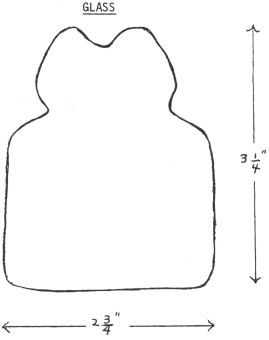 |
Similar to CD 540 though smaller.
My piece is broken
after the 7-. Obviously this is the date. Opposite on back is the mold no. 50.

|
PORCELAIN
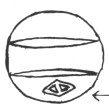 |
Mark on top of white porcelain U-1654 type. Lt. brown underglaze,
almost impossible to read. Seems to be symbols rather than letters. |
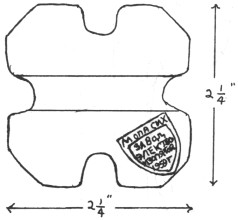 |
White
Porcelain Strain
Insulator Mark is stamped in black on unglazed bottom. The top
letters are partly illegible -- don't make sense -- probably an abbreviation.
The
next four lines mean:
|
Electro- |
1. |
Factory |
|
Insulator |
2. |
Electro- |
|
Factory |
3. |
Insulator |
|
4. |
1959-year |
|
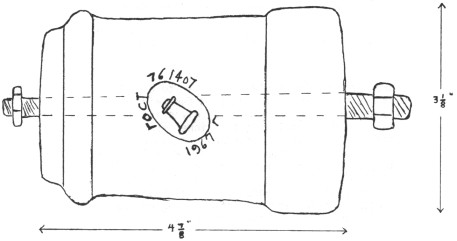
White porcelain insulator with brownish gray tint. It was
used at the point where support wires for overhead trolley car and trolley bus
lines came in to a pole or building. The underglaze marking is in dark green.
The letters are probably an abbreviation for "Government Transport".
The insulator's interior is filled with gray cement.
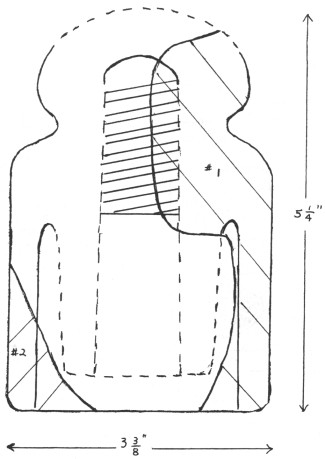
Brown porcelain insulator
similar to U-1278. It has been reconstructed from two fairly large fragments.
Fragment #1 gives virtually full height, shows height of inner skirt and
indicates extent of threaded hole, which (even though the top of the insulator
is missing) extends up so far that there is almost certainly no cable groove in
the top. The diameter of the threads, inner skirt and length of skirt are
estimated. Fragment #2 contains 1/3 of the base circle.
|
